#Periparus ater' Birds Bird little
Text
Monday 22nd March 2021
The Little Brown Birds
I had to put in an emergency online order for more bird seed yesterday and we’re still waiting for the half coconuts and Niger feeders to arrive. Honestly, the cast of thousands is eating us out of house and home. We had 25kg of seed delivered on the 18th February when we already had half a bin in stock, now we’re down to the very dregs and that’s without counting all the suet fatballs, fruit and other scraps we put out.
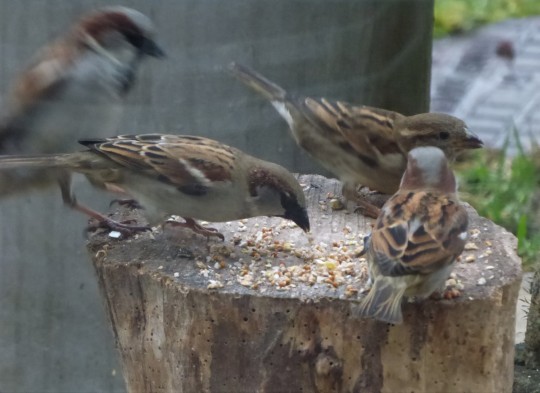
UK households did you remember to fill in your Census form? Residents and visitors included
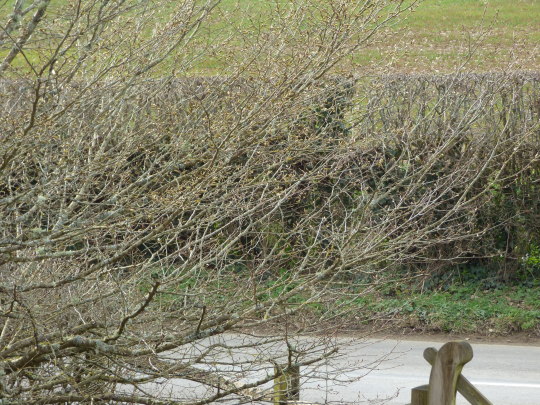
The Beech tree by the front gate, it’ll soon be in leaf again, hopefully
There’s still quite a chill in the breeze and I’ve had to order some repair glue for my walking boots because reading back my nature journal from a few years ago, we were out earlier in the year, well wrapped up and intrepid. Crow has been saying get new boots, but I like the ones I have, they’re comfortable too, all I need to do is make sure the sole doesn’t fall off.
To those promised little birds and I have two visitors who are hard to photograph as their visits are swift and they don’t stay still for long.
MARSH TIT: Status Red listed
Scientific Name: Poecile palustris
Length: 12 cm (4½")
Wing Span: 18-19 cm (7-8")
Weight: 10-12 g (¼-½ oz)
Breeding Pairs: 29,000 (BTO)
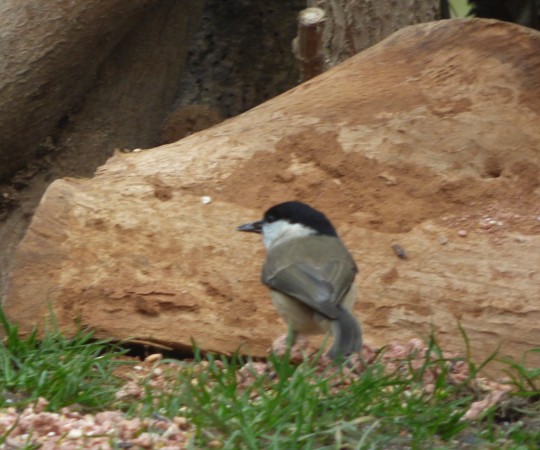
Marsh Tit with the plain black head
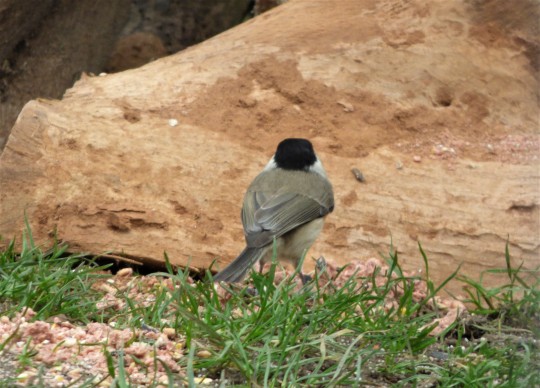
The Marsh Tit is incredibly difficult to distinguish from the even more scarce Willow Tit. There may not be too many Marsh Tits around but the Willow Tit is said to be the fastest declining native bird LINK (along with Turtle Dove) Both of them have black caps, sandy-brown upper parts and buff underparts.
It’s only at the turn of the last century that they were recognised as separate species and I’ve read that 2,750 pairs existed in 2016. The RSPB currently displays 3,400. I really hope it’s on the up.
We’re told
The Marsh Tit is less scruffy looking than the Willow Tit and has a neater, smaller bib and glossier black cap. Also, the Marsh Tit lacks the pale wing panel, does not look "bull-necked" and usually has a square-ended tail but is sometimes slightly forked.

Marsh Tit
Females build a cup shaped nest of moss, which they line with feathers and hair. They might use a nest box but like holes in deciduous trees.
Eggs are white with brown markings and are smooth and glossy. The female incubates the eggs by herself, but young nestlings are fed by both parents.

As if identification wasn’t confusing enough, juveniles have a dull cap and look very much like a Willow Tit.
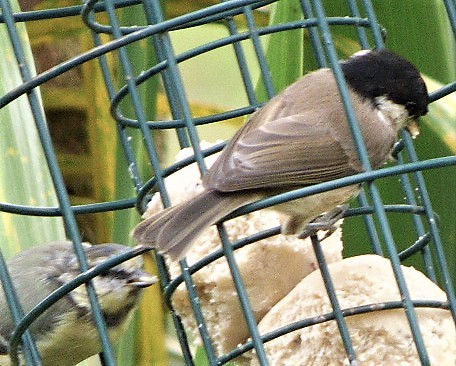
We see the Blue, Great and Long Tailed Tits at the hanging feeders much more so than Marsh Tits who like to feed on the ground more than the others. They’ll feed on insects and seeds and will go for Beech mast.
My guide says that peanuts, seeds and fat may attract them to gardens, but usually only if there are ancient woodlands nearby (contrary to their name, they do not live in marsh land). They are particularly fond of black sunflower seeds, but they’re in competition there with the Nuthatch.
Much more common place is the similar, but different,
COAL TIT: status Green listed
Scientific Name: Periparus ater
Length: 11.5 cm (4½")
Wing Span: 17-21 cm (7-8")
Weight: 8-10 g (¼-½ oz)
Breeding Pairs: 610,000 - 660,000 (BTO figure)
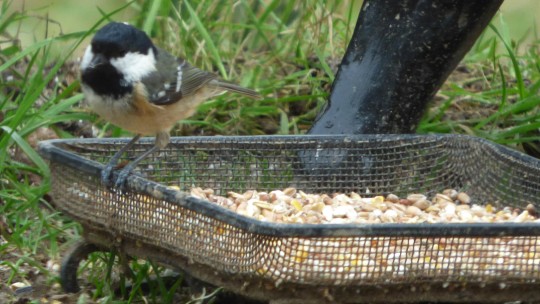
Coal Tit, you can just about make out the white patch on the head in the picture above, below show it more clearly
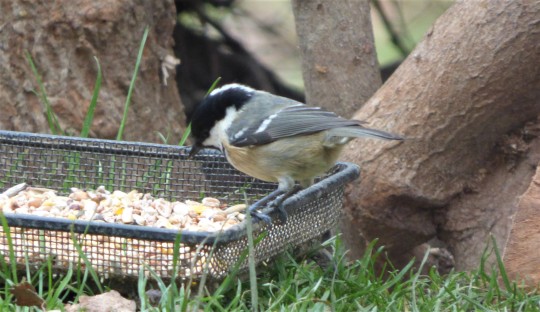
The Coal Tit is a small tit, in fact the smallest European tit, and could be confused with the almost indistinguishable Marsh Tit and Willow Tit if it was not for the white patch on the nape. While it behaves like a Blue Tit, there is no blue in its plumage. I do see them on the hanging feeders but more often on the ground
The upperparts are a olive-grey, the underparts buff coloured. The crown and large bib are black, while the cheeks and nape are white. There are also two white wing bars on each wing - this feature separates it from the Marsh and Willow Tits if the nape is not visible. The legs are blue-grey.
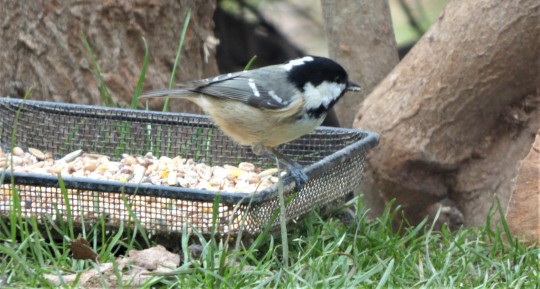
Coal Tit
Coal Tits will nest in hollows in trees or in mouse holes. Like a Blue Tit’s the nest can be made from moss, wool, dead leaves and spider web, except that it is moss-lined. They’ll be well suited here then both types.
The Coal Tit's small (15 mm by 12 mm) eggs are smooth and glossy, they’re white with reddish-brown speckles. Again the female incubates the eggs by herself and nestlings are fed by both parents.

Juveniles are browner above, and the underparts, cheeks, nape and wing bars are more yellow.
Again like the Marsh Tit, Coal Tit eat insects, beech mast and conifer seeds and in the garden they prefer black sunflower seeds, sunflower hearts and occasionally suet.
I’ve read that when food is plentiful they hoard it by hiding it so that they think they have food for later when times are harder, but like Squirrels the Coal Tit's memory is not as great as its ingenuity in hiding places and you will often find forgotten sunflower seeds germinating in the most unlikely places - well, we were there last year weren’t we, so perhaps it wasn’t Squirrels at work after all.
Great Tits can sometimes be seen watching a Coal Tit stashing away its seed and then go and raid it. Opportunists.
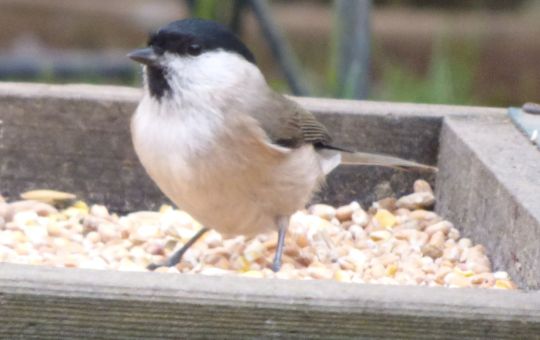
Marsh or Willow Tit? watch via You Tube.
youtube
Willow Tit news here.
WHAT DID I LEARN TODAY?
that I definitely need more sleep!
2 notes
·
View notes
Text
It was pouring with rain as I left London, on a RSPB group outing, for the 120-mile journey to Dorset and the RSPB reserve at Arne. Arne is situated on a peninsula which stands out into Poole Harbour, the largest natural harbour in the UK. It has a wondrous array of different habitats ranging from woodland to wetlands and heathland.
Saltmarsh (top), heathland (bottom left), farmland (bottom centre) and woodland (bottom right)
It continued to rain heavily as we passed through the new forest and it was not until we reached Bournemouth that there was a break in the rain, much to the relief of all – birdwatching in heavy rain is not much fun! Arriving at Arne, there was still rain in the air and so I opted for the northern part of the reserve, which contains the woodland and a hide overlooking one of the channels of the harbour. The woodland was quiet although there was a marked passage of Barn Swallows migrating south. At the hide overlooking the saltmarsh, there were 30 Spoonbills. This once rare bird from the Mediterranean area is now established in Dorset and Norfolk, another sign of our changing climate and birdlife.
There were also Oystercatchers, Eurasian Curlew, Common Redshank and Little Egrets feeding on the marsh.
Eurasian Curlew and Little Egret
Towards lunchtime I made my way back to the visitor’s centre and after lunch ventured south onto the heathland. By now the weather had changed completely and the rain had been replaced by bright sunshine. Heathland is not the most productive of bird habitats but it does provide a home to some special birds and one of these was my target for the afternoon. The Dartford Warbler is limited to heathland habitat. As one of our few resident warbler species, it has been severely hit in past years by hard winters and loss of habitat. Thankfully it does seem to be recovering and in some places like Arne flourishing – 70 pairs bred on the reserve this year. Even in this abundance, they remain a skulking bird and so finding one was not a guaranteed thing.

Dartford Warbler (adult male). Photo by Dave Curtis (https://www.flickr.com/photos/davethebird/)
As I made my way across the heath, I came across Helen, another of our party who had caught a brief glimpse of a bird in gorse and so we waited. Eventually, we were joined by one of the volunteer wardens and as the three of us waited we saw a small bird pop into a tree. But what was it, it was grey, darker above than below – certainly not the colours of a Dartford warbler. But then it came into clear view and it certainly looked like a Dartford, with its long tail cocked at an angle. It was one of this year’s young – I had never seen a juvenile before. Then there were other birds with it and eventually, 4 flew across to a nearby tree. at least one had the rich colours of a male and so we concluded we had a family group. We watched as they moved from bush to tree and back to gorse.
There was time left for a quick check over the Middlebere channel, but apart from a Shelduck and a large flock of Black-tailed Godwits, there was little to be seen. Then it was time to make my way back to the Visitor centre for a drink before we embarked on the journey back to London.
An excellent day, especially considering the weather on the way down, with Spoonbill and Dartford Warblers, the highlight of the day.
Common Shelduck (Tadorna tadorna)
Mallard [sp] (Anas platyrhynchos)
Eurasian Teal (Anas crecca)
Common Pheasant [sp] (Phasianus colchicus)
Eurasian Spoonbill [sp] (Platalea leucorodia)
Little Egret [sp] (Egretta garzetta)
Great Cormorant [sp] (Phalacrocorax carbo)
Eurasian Oystercatcher [sp] (Haematopus ostralegus)
Eurasian Curlew [sp] (Numenius arquata)
Black-tailed Godwit [sp] (Limosa limosa)
Dunlin [sp] (Calidris alpina)
Common Redshank [sp] (Tringa totanus)
Common Greenshank (Tringa nebularia)
Black-headed Gull (Chroicocephalus ridibundus)
Great Black-backed Gull (Larus marinus)
European Herring Gull [sp] (Larus argentatus)
Lesser Black-backed Gull [sp] (Larus fuscus)
Common Wood Pigeon [sp] (Columba palumbus)
Eurasian Collared Dove [sp] (Streptopelia decaocto)
Great Spotted Woodpecker [sp] (Dendrocopos major)
European Green Woodpecker [sp] (Picus viridis)
Common Kestrel [sp] (Falco tinnunculus)
Eurasian Jay [sp] (Garrulus glandarius)
Western Jackdaw [sp] (Coloeus monedula)
Carrion Crow [sp] (Corvus corone)
Coal Tit [sp] (Periparus ater)
Eurasian Blue Tit [sp] (Cyanistes caeruleus)
Great Tit [sp] (Parus major)
Sand Martin [sp] (Riparia riparia)
Barn Swallow [sp] (Hirundo rustica)
Common House Martin [sp] (Delichon urbicum)
Long-tailed Tit [sp] (Aegithalos caudatus)
Dartford Warbler [sp] (Sylvia undata)
Eurasian Nuthatch [sp] (Sitta europaea)
Common Starling [sp] (Sturnus vulgaris)
Common Blackbird [sp] (Turdus merula)
European Robin [sp] (Erithacus rubecula)
European Stonechat [sp] (Saxicola rubicola)
House Sparrow [sp] (Passer domesticus)
Meadow Pipit (Anthus pratensis)
Common Chaffinch [sp] (Fringilla coelebs)
European Goldfinch [sp] (Carduelis carduelis)
Common Reed Bunting [sp] (Emberiza schoeniclus)
Naturelog: 23rd September It was pouring with rain as I left London, on a RSPB group outing, for the 120-mile journey to Dorset and the RSPB reserve at Arne.
0 notes
Text
A short drive today brings us to Pensthorpe Nature Reserve. This is a private reserve founded by a local landowner and businessman Bill Jordon. It is part wildfowl collection; part conservation centre and part nature reserve. It is also the centre of a local partnership seeking to combine modern farming and good habitat for wildlife. It has a diverse range of habitats and our first stop is at the wader scrape, where there are a number of species of geese and other waterbirds.
From here we pass on into the woodland and from the hide, we have excellent views of Nuthatch, Coal Tit and Marsh Tit along with more common woodland birds.
Nuthatch and Great Tit
After stopping at the visitor centre for lunch we visit the wetland hide, where 2 Green Sandpipers and a female Goldeneye are the best birds to be seen.
Goldeneye (f) (top left), Little Grebe (bottom left), Moorhen (top right), Eurasian Teal (centre right) and Egyptian Goose (bottom right).
Greylag Goose [sp] (Anser anser)
Mute Swan (Cygnus olor)
Egyptian Goose (Alopochen aegyptiaca)
Gadwall [sp] (Mareca strepera)
Eurasian Wigeon (Mareca penelope)
Mallard [sp] (Anas platyrhynchos)
Eurasian Teal (Anas crecca)
Common Pochard (Aythya ferina)
Tufted Duck (Aythya fuligula)
Common Goldeneye [sp] (Bucephala clangula)
Common Pheasant [sp] (Phasianus colchicus)
Little Grebe [sp] (Tachybaptus ruficollis)
Great Crested Grebe [sp] (Podiceps cristatus)
Little Egret [sp] (Egretta garzetta)
Great Cormorant [sp] (Phalacrocorax carbo)
Red Kite [sp] (Milvus milvus)
Common Buzzard [sp] (Buteo buteo)
Common Moorhen [sp] (Gallinula chloropus)
Eurasian Coot [sp] (Fulica atra)
Northern Lapwing (Vanellus vanellus)
Common Snipe [sp] (Gallinago gallinago)
Green Sandpiper (Tringa ochropus)
Ivory Gull (Pagophila eburnea)
Black-headed Gull (Chroicocephalus ridibundus)
Mew Gull [sp] (Larus canus)
European Herring Gull [sp] (Larus argentatus)
Common Wood Pigeon [sp] (Columba palumbus)
Western Barn Owl [sp] (Tyto alba)
Peregrine Falcon [sp] (Falco peregrinus)
Eurasian Jay [sp] (Garrulus glandarius)
Western Jackdaw [sp] (Coloeus monedula)
Carrion Crow [sp] (Corvus corone)
Coal Tit [sp] (Periparus ater)
Marsh Tit [sp] (Poecile palustris)
Eurasian Blue Tit [sp] (Cyanistes caeruleus)
Great Tit [sp] (Parus major)
Barn Swallow [sp] (Hirundo rustica)
Eurasian Nuthatch [sp] (Sitta europaea)
Common Starling [sp] (Sturnus vulgaris)
Common Blackbird [sp] (Turdus merula)
European Robin [sp] (Erithacus rubecula)
House Sparrow [sp] (Passer domesticus)
Dunnock [sp] (Prunella modularis)
Common Chaffinch [sp] (Fringilla coelebs)
Norfolk Journey 2018: Day 12 A short drive today brings us to Pensthorpe Nature Reserve. This is a private reserve founded by a local landowner and businessman Bill Jordon.
0 notes
Text
Kieth and I spent the morning at Staines Reservoir looking for the American Horned Lark, which is still present. As on my previous visit, it did not take us long to find the obliging bird.
As we left the reservoir, a pair of Little Grebes were seen and there was a group of Fieldfare on the bank.
We stopped off at the London Wetland Centre on the way home for a couple of hours.
Shelduck (centre left), Eurasian Wigeon (Bottom left) and Rose-ringed Parakeet (right)
Canada Goose [sp] (Branta canadensis)
Mute Swan (Cygnus olor)
Common Shelduck (Tadorna tadorna)
Northern Shoveler (Spatula clypeata)
Gadwall [sp] (Mareca strepera)
Eurasian Wigeon (Mareca penelope)
Mallard [sp] (Anas platyrhynchos)
Eurasian Teal (Anas crecca)
Tufted Duck (Aythya fuligula)
Little Grebe [sp] (Tachybaptus ruficollis)
Great Crested Grebe [sp] (Podiceps cristatus)
Great Cormorant [sp] (Phalacrocorax carbo)
Common Moorhen [sp] (Gallinula chloropus)
Eurasian Coot [sp] (Fulica atra)
Northern Lapwing (Vanellus vanellus)
Common Redshank [sp] (Tringa totanus)
Black-headed Gull (Chroicocephalus ridibundus)
Great Black-backed Gull (Larus marinus)
European Herring Gull [sp] (Larus argentatus)
Lesser Black-backed Gull [sp] (Larus fuscus)
Feral Rock Dove [sp] (Columba livia)
Common Wood Pigeon [sp] (Columba palumbus)
Eurasian Collared Dove [sp] (Streptopelia decaocto)
Rose-ringed Parakeet [sp] (Psittacula krameri)
Eurasian Magpie [sp] (Pica pica)
Western Jackdaw [sp] (Coloeus monedula)
Carrion Crow [sp] (Corvus corone)
Coal Tit [sp] (Periparus ater)
Eurasian Blue Tit [sp] (Cyanistes caeruleus)
Great Tit [sp] (Parus major)
Long-tailed Tit [sp] (Aegithalos caudatus)
Eurasian Wren [sp] (Troglodytes troglodytes)
Common Starling [sp] (Sturnus vulgaris)
Common Blackbird [sp] (Turdus merula)
Fieldfare (Turdus pilaris)
Redwing [sp] (Turdus iliacus)
Mistle Thrush [sp] (Turdus viscivorus)
European Robin [sp] (Erithacus rubecula)
Dunnock [sp] (Prunella modularis)
Pied Wagtail [sp] (Motacilla alba)
Meadow Pipit (Anthus pratensis)
Common Chaffinch [sp] (Fringilla coelebs)
European Greenfinch [sp] (Chloris chloris)
Naturelog: 24th February Kieth and I spent the morning at Staines Reservoir looking for the American Horned Lark, which is still present.
0 notes